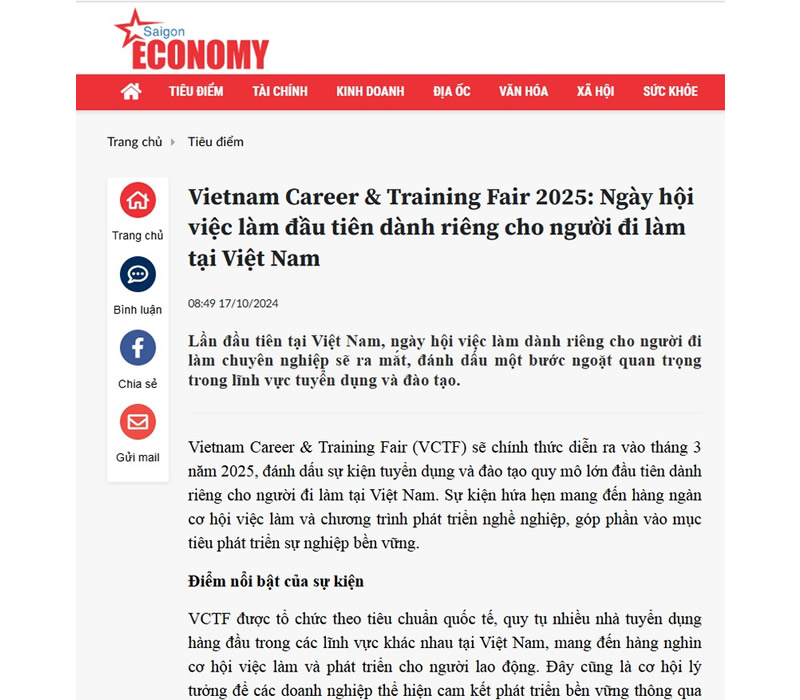
VIETNAM CAREER & TRAINING FAIR
First career & training fair for professionals in Vietnam
Connecting – Recruiting – Branding
Vietnam Career & Training Fair (VCTF) will be held for the first time in 2025 and will become an annual event thereafter, marking the premier career and training event for professionals in Vietnam. The event offers thousands of job opportunities and career development programs, contributing to the goal of a sustainable career path.



EVENT’S HIGHLIGHTS
Pioneering Vietnam annual career & training fair
With the mission of creating a leading career fair in Vietnam, VCTF will be held annually starting in 2025Featuring
Top
Companies
Featuring top
employers across
various industries in
Vietnam, including
companies honored as
the “Best Companies to
Work for in Asia” by HR
Asia Organised with International Standard
VCTF is organised to international standards, with 22+ years of experience organized in AsiaBacked by
Leading
Organizations
Supportively organized by
prestigious partners and
associations such as AiC,
Aniday, Cake, CEEC,
ICHAM, etc. Showcasing
ESG
Commitment
A great opportunity for
businesses to showcase
their commitment to
sustainability through
ESG-aligned programs
and career opportunities,
attracting top talent with
shared values WHO SHOULD ATTEND?

| Company | Jobseeker | |
|---|---|---|
|
Career
|
Multinational
corporations and
top companies
seeking to recruit
and enhance
employer branding
|
Professionals and
job seekers looking
to explore,
connect, and
advance their
careers and skills
|
|
Training
|
Career consulting
organizations,
training institutions
|
Graduates looking
to upgrade their
qualifications
|
VCTF’S HIGHLIGHT ACTIVITIES

Interview Booths

International Career Summit

Workshops on Career Growth
and Skill Enhancement

Panel Discussions
and career paths

CV Consultation and Adjustment Zone

Other activities
SOME BOOTH IMAGES







INTERNATIONAL CAREER SUMMIT

A forum featuring top experts sharing insights and trends in career development
Some expected topics:
Panel 1 | The Journey to Sustainable Career Development Panel 2 | Personal Finance Management for Professionals Panel 3 | What to Learn After Entering the Workforce
AGENDA*
Day 1 | Career topics
*Expected Agenda
8:30 – 9:00 AM
Event Opening | Opening Remarks and Strategic Partnership Signings
between Businesses, Universities, and Training Organizations
9:00 – 11:00 AM
Panel Discussion 1 | The Journey to Sustainable Career
Development
Hosted by Sales, Marketing, Tech, HR, Finance, and Legal Affairs Directors from VCTF Participating Companies
Hosted by Sales, Marketing, Tech, HR, Finance, and Legal Affairs Directors from VCTF Participating Companies
2:00 – 3:00 PM
Talkshow 1 | Effective Job Hunting Strategies
Hosted by Cake
Hosted by Cake
3:00 – 4:00 PM
Talkshow 2 | Leveraging LinkedIn for Career Development
Hosted by Aniday
Hosted by Aniday
4:00 – 5:00 PM
Talkshow 3 | Conquering Management Trainee Programs
Hosted by Managers Grew from Management Trainee Programs
Hosted by Managers Grew from Management Trainee Programs
Day 2 | Training topics
*Expected Agenda
9:00 – 10:00 AM
Talkshow 4 | Skills to Seize Future Job Opportunities
Hosted by Training Experts
Hosted by Training Experts
10:10 – 11:30 AM
Panel Discussion 2 | Personal Finance Management for Professionals
Hosted by Seniors from Financial Institutions, Banks, Insurance Companies, and Fund Management Organisations
Hosted by Seniors from Financial Institutions, Banks, Insurance Companies, and Fund Management Organisations
2:00 – 4:00 PM
Panel Discussion 3 | What to learn for professionals?
Hosted by Senior Managers from Businesses and Training Organisations
Hosted by Senior Managers from Businesses and Training Organisations
4:00 PM
Closing
WORKSHOPS AT UNIVERSITIES

Workshops offer students and graduates insights into the job market, career development, and essential skills.
Great chance for VCTF’s exhibitor to meeting future talents, direct meeting with potential trainee, introducing company’s highlight to them and enhance brand awareness.
Register your booth at VCTF today to connect, recruit top talent, and elevate your employer brand!
SPECIAL OFFERS for new exhibitors
Please contact the organiser for more information
Email: Contact@vctf.asia
Phone: 0868 586 123
TIME & DATE
09:00 – 18:00
14 & 15 JUNE 2025
GEM CENTER, 08 NGUYEN BINH KHIEM, DA KAO WARD, DIST. 1,
HCMC
NUMEROUS NEWSPAPERS REPORTED ON VCTF





























